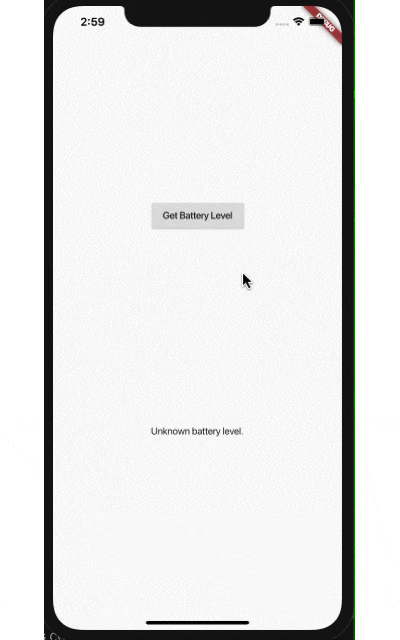FlutterからネイティブAPIを呼びたい
MethodChannelを使って、FlutterからJava(Android)とObjective-C(iOS)のネイティブコード呼び出しを試してみました。
Writing custom platform-specific codeに記載のサンプルコードを動かしてみたので、実際の流れをメモしておきます。
Kotlin/Swift版はこちら
FlutterからKotlin/Swiftのネイティブコードを呼んでみた - Qiita
サンプルソースはこちら
https://github.com/unsolublesugar/flutter-sample-custom-platform-specific-code-java-objc
サンプルプロジェクトの作成
まずはサンプルプロジェクトを作成します。サンプルアプリでは、バッテリー残量を取得するネイティブコードを実装します。
Flutter v1.9.1では、デフォルトのネイティブ言語がKotlinとSwiftになっていたので、オプション指定でJava/Objective-Cでプロジェクト作成します。
$ flutter create -i objc -a java batterylevel
VSCodeでプロジェクト作成している場合は、設定の [Extensions] -> [Dart & Flutter] にて使用言語の切り替えが可能です。「flutter create language」で検索すると一発で設定にアクセスできます。

Flutter側の呼び出しコード
サンプル画面のWidgetとバッテリー残量取得メソッドの実装を加えます。以下、_MyHomePageStateのみ抜粋したmain.dartファイルです。
import 'dart:async';
import 'package:flutter/material.dart';
import 'package:flutter/services.dart';
...
class _MyHomePageState extends State<MyHomePage> {
static const platform = const MethodChannel('samples.flutter.dev/battery');
String _batteryLevel = 'Unknown battery level.';
Future<void> _getBatteryLevel() async {
// Get battery level.
String batteryLevel;
try {
final int result = await platform.invokeMethod('getBatteryLevel');
batteryLevel = 'Battery level at $result % .';
} on PlatformException catch (e) {
batteryLevel = "Failed to get battery level: '${e.message}'.";
}
setState(() {
_batteryLevel = batteryLevel;
});
}
@override
Widget build(BuildContext context) {
return Material(
child: Center(
child: Column(
mainAxisAlignment: MainAxisAlignment.spaceEvenly,
children: [
RaisedButton(
child: Text('Get Battery Level'),
onPressed: _getBatteryLevel,
),
Text(_batteryLevel),
],
),
),
);
}
}
MethodChannelで呼び出すバッテリー残量取得メソッドgetBatteryLevelは、JavaとObjective-C側でそれぞれ定義していきます。
Java側のネイティブコード(Android)
それではJava(Android)のコードを書いていきましょう。
必要なimportの追加
MainActivity.javaにimportを追加。
import android.os.Bundle;
import android.content.ContextWrapper;
import android.content.Intent;
import android.content.IntentFilter;
import android.os.BatteryManager;
import android.os.Build.VERSION;
import android.os.Build.VERSION_CODES;
import io.flutter.app.FlutterActivity;
import io.flutter.plugins.GeneratedPluginRegistrant;
import io.flutter.plugin.common.MethodCall;
import io.flutter.plugin.common.MethodChannel;
import io.flutter.plugin.common.MethodChannel.MethodCallHandler;
import io.flutter.plugin.common.MethodChannel.Result;
getBatteryLevelを実装
MainActivityのonCreateメソッド内でMethodChannelを定義し、setMethodCallHandlerを呼び出します。
public class MainActivity extends FlutterActivity {
private static final String CHANNEL = "samples.flutter.dev/battery";
@Override
public void onCreate(Bundle savedInstanceState) {
super.onCreate(savedInstanceState);
GeneratedPluginRegistrant.registerWith(this);
new MethodChannel(getFlutterView(), CHANNEL).setMethodCallHandler(
new MethodCallHandler() {
@Override
public void onMethodCall(MethodCall call, Result result) {
}
});
}
}
ここで定義したチャンネル名samples.flutter.dev/batteryを、Flutter側の呼び出しで使用します。
Android端末のバッテリーレベルを取得するコードを追加します。
private int getBatteryLevel() {
int batteryLevel = -1;
if (VERSION.SDK_INT >= VERSION_CODES.LOLLIPOP) {
BatteryManager batteryManager = (BatteryManager) getSystemService(BATTERY_SERVICE);
batteryLevel = batteryManager.getIntProperty(BatteryManager.BATTERY_PROPERTY_CAPACITY);
} else {
Intent intent = new ContextWrapper(getApplicationContext()).
registerReceiver(null, new IntentFilter(Intent.ACTION_BATTERY_CHANGED));
batteryLevel = (intent.getIntExtra(BatteryManager.EXTRA_LEVEL, -1) * 100) /
intent.getIntExtra(BatteryManager.EXTRA_SCALE, -1);
}
return batteryLevel;
}
getBatteryLevel()をMethodChannel で呼び出すコードを追加。
@Override
public void onMethodCall(MethodCall call, Result result) {
// Note: this method is invoked on the main thread.
if (call.method.equals("getBatteryLevel")) {
int batteryLevel = getBatteryLevel();
if (batteryLevel != -1) {
result.success(batteryLevel);
} else {
result.error("UNAVAILABLE", "Battery level not available.", null);
}
} else {
result.notImplemented();
}
}
これでAndroid用Javaネイティブコードの呼び出し準備は完了です。
エミュレーター上で実行
上記コードをエミュレーター上でbuild runすると「Get Battery Level」ボタンと「Unknown battery level.」テキストが表示されます。
ボタンタップで、端末のバッテリー残量を取得。テキスト表示が切り替わります。
Objective-C側のネイティブコード(iOS)
続いてObjective-C(iOS)のコードを書いていきます。
対象プロジェクト内のiosフォルダを開き、Runnerフォルダ配下にあるAppDelegate.mを開きます。
getBatteryLevelを実装
Androidと同じくMethodChannelの実装を定義します。
# include "AppDelegate.h"
# include "GeneratedPluginRegistrant.h"
@implementation AppDelegate
- (BOOL)application:(UIApplication *)application
didFinishLaunchingWithOptions:(NSDictionary *)launchOptions {
FlutterViewController* controller = (FlutterViewController*)self.window.rootViewController;
FlutterMethodChannel* batteryChannel = [FlutterMethodChannel
methodChannelWithName:@"samples.flutter.dev/battery"
binaryMessenger:controller];
[batteryChannel setMethodCallHandler:^(FlutterMethodCall* call, FlutterResult result) {
}];
[GeneratedPluginRegistrant registerWithRegistry:self];
// Override point for customization after application launch.
return [super application:application didFinishLaunchingWithOptions:launchOptions];
}
@end
@endの手前にバッテリーレベルの取得メソッドgetBatteryLevelを追加。
- (int)getBatteryLevel {
UIDevice* device = UIDevice.currentDevice;
device.batteryMonitoringEnabled = YES;
if (device.batteryState == UIDeviceBatteryStateUnknown) {
return -1;
} else {
return (int)(device.batteryLevel * 100);
}
}
setMethodCallHandlerでgetBatteryLevelを呼び出します。
__weak typeof(self) weakSelf = self;
[batteryChannel setMethodCallHandler:^(FlutterMethodCall* call, FlutterResult result) {
if ([@"getBatteryLevel" isEqualToString:call.method]) {
int batteryLevel = [weakSelf getBatteryLevel];
if (batteryLevel == -1) {
result([FlutterError errorWithCode:@"UNAVAILABLE"
message:@"Battery info unavailable"
details:nil]);
} else {
result(@(batteryLevel));
}
} else {
result(FlutterMethodNotImplemented);
}
}];
iOS Simulatorを起動すると、Android同様にボタンとテキストが表示されます。ボタンをタップするとMethodChannel経由でgetBatteryLevel()が呼び出されテキストが更新されます。

iOS Simulator上ではバッテリーAPIがサポートされていないため「Battery info unavailable」という表示が出ます。これでObjective-C側で書いたコードが動いていることがわかりますね。
Flutterは公式ドキュメントが恐ろしく充実してて最高。
